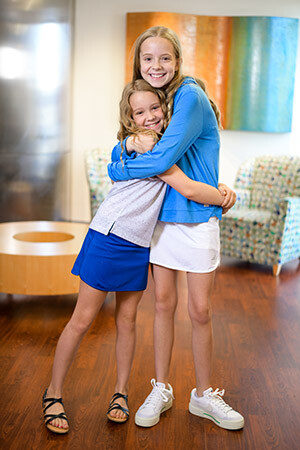
Riley
Passionate Advocacy Brings Riley Strength and Joy on her Healing Journey
Riley was beyond discouraged. Diagnosed with heart failure, she lay in her hospital bed at Children’s Health℠ in Dallas thinking about that day in late November 2018 that had come out of the blue and completely sidelined her active life.
Riley, 7, had been on a school field trip on that fateful day. The bus had stopped at a park where she and her classmates could play for a bit and eat lunch before they arrived at their destination. That’s when she started throwing up — and couldn’t stop. Her mom drove to the park and got her. She ended up in the hospital. The doctors thought she might have pneumonia, but within a week, her family was grappling with a far more terrifying reality: A nagging cold virus had attacked her heart muscle and permanently reduced the organ’s ability to pump blood. The damaging inflammation caused by the virus, called myocarditis, meant Riley needed a new heart.
A bridge to transplant

Within days of being transferred to the Solid Organ Transplant Center at Children’s Health in Dallas, the left side of the little girl’s heart gave out and she underwent open-heart surgery to implant a left ventricular assist device (LVAD) in her lower left heart chamber.
The LVAD is a pump. Tubes attached to Riley’s heart were connected to mechanical parts outside her body. Just like a heart, the device circulated blood — and bought her the precious time she needed to wait for a donor heart.
Though the LVAD worked just fine, Riley continued to head downhill fast.
The right side of her heart flatlined because of a leaking heart valve, she had to go on kidney dialysis to remove the resulting buildup of fluid, and a ventilator was helping her breathe. And after all that, Riley had to have a second surgery to implant a right ventricular assist device (RVAD).
“Every day during rounds, Riley witnessed a culture where each member of her team was empowered to speak up,” Lisa said. “That’s when she became a really big advocate for herself.”
Life beyond the hospital bed
For two solid months Riley had been in bed — and each day she seemed more unhappy. It was common knowledge that children with bi-VADs (both a left and a right VAD) didn’t leave their hospital beds, much less their rooms. The safety concerns around disconnecting the electrical cord that powers two heart pumps, switching over to battery power and taking the risk of something bad happening when the child was up had always seemed too problematic for clinical staff and parents alike.
But that didn’t stop Lisa who knew in her heart that Riley needed to be active.
“At first, we started going onto battery power and walking the halls with two nurses in tow,” Lisa said. “Over time, I proved that I was knowledgeable enough to handle our walks without the nurses. We had this huge meeting about leaving our room and our nurses advocated for Riley. They saw that when she was active and outside the room, she was joyful and much healthier. And when she wasn't, her sadness spiked. The entire team really cared about her whole being and they didn’t want to put her on antidepressants.”
Responsibility . . . and shenanigans
After getting the green light to walk around the hospital, Riley felt empowered to ask the nurses if she could clean her incision sites and change her own bandages.
And it wasn’t all work and no play. Once Riley’s nurses felt confident with her pump on battery power, the real fun started. Not only did Riley and her clinical comrades decorate the doctors’ offices at night, they also raced tricycles down the halls and enjoyed Nerf gun fights and silly string wars. Once, they even covered her VADs in plastic wrap and went outside for a friendly skirmish with water guns!
Not being in bed the whole time made me happy and helped me get stronger. Also, when I walked past the rooms of other kids who were on VADs, I showed them that they could get out of bed, too.
— Riley
Code word: pineapple
Lisa lived at Children’s Health for six months before she decided to spend the day with Riley’s three sisters at home, instead of hosting their usual visit at the hospital.
“I arranged for friends to sit with Riley, but I was worried about what I’d do if the call came in that a heart was available,” she explained. “I told our team, ‘don’t call me and ask if we want the heart. If it’s one that you'd put in your own kid, call me and say the word pineapple and I'll know you're for real.’"

Once home, Lisa answered a FaceTime video call from the team. Riley’s doctors and nurses stood together in silence and one held up a clear cup containing pineapple slices.
“They asked me if they could go tell Riley that the perfect heart for her was on its way,” Lisa said, her eyes welling up. “They’d pre-ordered Spiderman masks just for the day they all hoped would come. I wish I could have seen my daughter’s face when 15 people walked into her room with a pineapple cup and face masks.”
A bright future
Riley, now 12, was so inspired by members of her clinical team who also have “zippers” — scars from open-heart surgeries — that she dreams of being a cardiac nurse or a surgeon. For now, she loves playing defense on her school’s basketball team, hanging out with friends and taking trips with her family.
Riley said she knew she was going to make it because she had so many loving people around her, including donors who helped fund the care and equipment that saved her life.
Lisa summed up their life-changing experience:
I tell everyone to go to Children's Health because the doctors and nurses are empowered to fight for the very best care, and they also respect the things patients and parents advocate for. It’s truly amazing.
— Lisa, Riley's mom
Meet more Children's Health patients
Read more patient stories like Riley's and meet our Patient Ambassadors to learn how Children's Health makes life better for children.
Kids count on us. We count on you.
Give to support innovative research, lifesaving treatments and compassionate care.
Did you enjoy this story?
If you would like to receive an email when new stories like this one are posted to our website, please complete the form below. We won't share your information, and you can unsubscribe any time.

